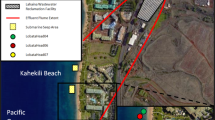Abstract
Coral growth rate and the concentrations of fulvic acid in the growth bands of the hermatypic coral Porites lutea Edwards & Haime and Favia maxima Veron were investigated in samples taken from 1986 to 1988 in the waters of southern Taiwan (22°05′≈36′N, 120°24′≈50′E). These were analyzed against the local annual precipitation, the locality of the sampling sites, the construction activity on nearby land and coral species. The results showed that the annual growth rate of P. lutea was 1.08±0.12 cm while F. maxima was 0.83±0.09 cm. The amount of fulvic acid incorporated in the growth band was positively correlated with the local annual precipitation. However, the correlation coefficient varied from as high as 0.9519 to as low as 0.0921 due to different topographies of the sampling sites, dilution factors from the ocean and construction activities along the coast. F. maxima was found to be more sensitive than P. lutea in terms of fulvic acid uptake from the surrounding waters. The study of fluorescence in the skeleton of hermatypic corals is a reasonable approach to biomonitor the environment after consideration of local factors.
Similar content being viewed by others
References
Bak RPM, Laane WPM (1987) Annual black bands in skeletons of reef corals. Mar Ecol Prog Ser 38:169–175
Barnard LA, Macintyre IG, Pierce JW (1974) Possible environmental index in tropical reef corals. Nature 252:210–220
Boto K, Isdale P (1985) Fluorescent bands in massive corals result from terrestrial fulvic acid inputs to nearshore zone. Nature 315:96–397
Chen CTA, Chang KH, Fang LS (1992) Recent changes of zinc and Sr-90 in banded corals in southern Taiwan. In: Marsh J (ed) “Asia-Pacific Marine Resources and Development”. Taylor and Francis, New York (in press)
Cortes J, Risk MJ (1985) A reef under siltation stress: Cahuita, Costa Rica. Bull Mar Sci 36:339–356
Dodge RE, Vaisnys JR (1975) Hermatypic coral growth banding as environmental recorder. Nature 258:706–708
Dodge RE, Jickells TD, Knap AH, Boyd S, Bak RPM (1984) Reef-building coral skeletons as chemical pollution (Phosphorus) indicators. Mar Pollut Bull 15:178–187
Druffel EM (1982) Banded corals: changes in oceanic carbon-14 during the little ice age. Science 218:13–19
Flor TH, More WS (1977) Radium/calcium and uranium/calcium determinations for western atlantic reef corals. Proc 3rd Int Coral Reef Symp 2:555–562
Goreau TJ (1977) Coral skeletal chemistry: physiological and environmental regulation of stable isotopes and trace metals in Montastrea annularis. Proc R Soc London Ser B 196:291–315
Hudson JH, Shinn EA, Halley RB, Lidz B (1976) Sclerochronology-a tool for interpreting past environments. Geology 4:361–364
Isdale PJ (1984) Fluorescent bands in massive corals record centuries of coastal rainfall. Nature 310:578–579
Isdale PJ (1988) Construction of historical analogues of terrestrial runoff inputs to reef areas using fluorescing bands in nearshore massive coral (abstract). 6th Int Coral Reef Symp, Townsville, Australia, p 200
Ma TYH (1937) On the growth rate of reef corals and its relation to sea water temperature. Palaeont Sin Ser B 16:1–426
Meyers-Schulte KJ, Hedges JI (1986) Molecular evidence for a terrestrial component of organic matter dissolved in ocean water. Nature 321:61–63
Patzold J (1984) Growth rhythms recorded in stable isotopes and density bands in the reef coral Porites lobata (Cebu, Philippines). Coral Reefs 3:87–90
Scoffin TP, Tudhope AW, Brown BE (1989) Fluorescent and skeletal density banding in Porites lutea from Papua New Guinea and Indonesia. Coral Reefs 7:169–178
Stuermer DH, Harvey GR (1974) Humic substances from sea water. Nature 250:480–481
Wang CH, Huang CY (1987) Oxygen and carbon isotope records in the coral Favia speciosa of Nanwan bay, Southern Taiwan. Acta Oceanogr Taiwanica 18:150–157
Wang CH, Huang CY (1989) The eleven-year isotopic records in the coral Favia speciosa of Nanwan bay, southern Taiwan. Acta Oceanogr Taiwanica 24:96–107
Author information
Authors and Affiliations
Rights and permissions
About this article
Cite this article
Fang, LS., Chou, YC. Concentration of fulvic acid in the growth bands of hermatypic corals in relation to local precipitation. Coral Reefs 11, 187–191 (1992). https://doi.org/10.1007/BF00301991
Accepted:
Issue Date:
DOI: https://doi.org/10.1007/BF00301991



